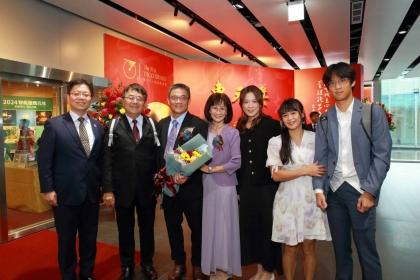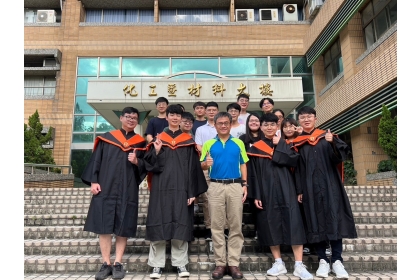NCHU Professor Ching-Hsuan Lin Honored with TECO Award for Pioneering Green Materials in Industrial Transformation
2024-11-11
興新聞張貼者
Unit秘書室
1,524
Professor Ching-Hsuan Lin, a distinguished professor in the Department of Chemical Engineering at National Chung Hsing University (NCHU), was awarded the TECO Award on November 9 in recognition of his work in green material innovation. Over the past two decades, Professor Lin has led pioneering research in environmentally friendly materials, developing the world’s first halogen-free printed circuit board substrates, recyclable and degradable wind turbine blades, low-dielectric materials for 5G communications, and upcycled plastic recycling technologies. These breakthroughs address challenges of industrial pollution and difficult recycling processes, balancing environmental protection with commercial scalability. Many of his technologies have already been transferred to industry, aiding businesses in their green transition.
Professor Lin joined NCHU in 2003, dedicating his career to green chemistry, circular materials, and functional product development. His team has developed a high-performance, recyclable epoxy resin suitable for wind turbine blade infusion, which enhances recyclability without requiring changes to existing manufacturing processes. In collaboration with industry partners, they have produced degradable and recyclable wind turbine blades measuring 91, 105, and 120 meters in length.
Additionally, his team has pioneered plastic upcycling and recycling techniques, converting discarded polycarbonate into vitrimers, a type of glass-like polymer with high hydrolytic stability and thermal performance, paving the way for new applications in plastic circular economy. In the realm of high-frequency communication technology, they successfully integrated liquid crystal polymer alignment technology into modified polyimide, achieving a dielectric loss as low as 0.002, which is ideal for high-frequency communication flexible circuits. Lin also developed modified polyphenylene oxide (PPO) resins based on bio-based materials, with dielectric properties comparable to those of products from renowned companies like SABIC and Mitsubishi Chemical.
In accepting the award, Professor Lin expressed gratitude for the recognition of his and his team’s efforts, stating that this honor motivates him to continue advancing green chemistry and sustainable development through innovative environmental solutions. He hopes this achievement will attract more interdisciplinary industrial partnerships, accelerating the practical application of laboratory research and creating greater societal value.
Professor Lin joined NCHU in 2003, dedicating his career to green chemistry, circular materials, and functional product development. His team has developed a high-performance, recyclable epoxy resin suitable for wind turbine blade infusion, which enhances recyclability without requiring changes to existing manufacturing processes. In collaboration with industry partners, they have produced degradable and recyclable wind turbine blades measuring 91, 105, and 120 meters in length.
Additionally, his team has pioneered plastic upcycling and recycling techniques, converting discarded polycarbonate into vitrimers, a type of glass-like polymer with high hydrolytic stability and thermal performance, paving the way for new applications in plastic circular economy. In the realm of high-frequency communication technology, they successfully integrated liquid crystal polymer alignment technology into modified polyimide, achieving a dielectric loss as low as 0.002, which is ideal for high-frequency communication flexible circuits. Lin also developed modified polyphenylene oxide (PPO) resins based on bio-based materials, with dielectric properties comparable to those of products from renowned companies like SABIC and Mitsubishi Chemical.
In accepting the award, Professor Lin expressed gratitude for the recognition of his and his team’s efforts, stating that this honor motivates him to continue advancing green chemistry and sustainable development through innovative environmental solutions. He hopes this achievement will attract more interdisciplinary industrial partnerships, accelerating the practical application of laboratory research and creating greater societal value.




